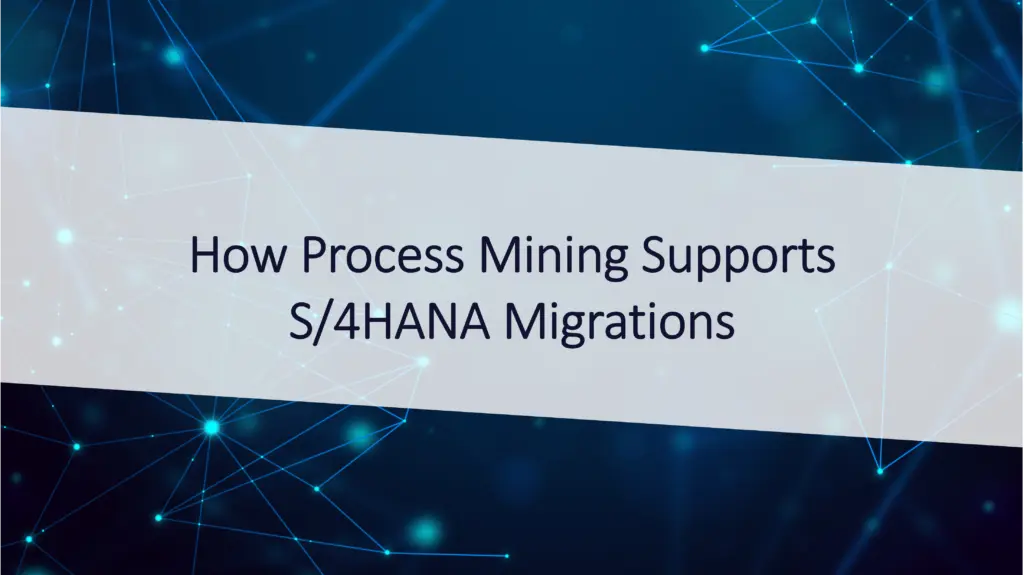In recent years, more organizations have been undertaking the modernization of their ERP technology platform from SAP ECC to S/4HANA. As the ECC legacy support 2025 date looms, we see more clients sharing/starting their S/4HANA discussions, business cases and asking for us to join them. Although SAP extended support for the more recent versions of ECC (6/7/8) into 2027, companies are not delaying their migration timelines or efforts. The digital modernization decision allows companies to stay competitive and improve multiple operational areas due to the increased benefits which come with S/4HANA. With any technology migration, and S/4HANA is no different, migrations are typically plagued with issues in every phase but most negatively within the implementation phase. However, in 2023… Process Mining should assume a key role in every digital migration and with this addition of Process Mining into a structured migration, there are key benefits in process normalization, grasping the as-is and to-be states of processes, orchestrating the MDM, and identifying the “previously unknown” into view (and early).
Why take part in modernizing your SAP
Modernizing is turning out to be progressively significant as an ever-increasing number of organizations work in a globalized, interconnected world. Organizations should supplement or replace their legacy systems and processes. These legacy systems are inflexible, slow and negatively influence business execution. As of now, there are different use cases for leveraging Process Mining within S/4HANA migrations; the two most significant are pre- and post-migration (e.g., planning and monitoring). These are ProcessOwl’s specialized areas of expertise.
Process Mining can contribute to a bunch of ways. For example, Process Mining assists in identifying the most efficient processes and those containing more variability allowing for targeted solutioning by the business and migration team; saving time and wasted resource efforts. When migrating to an entirely new platform, i.e., S/4HANA, Process Mining is useful to better understand current state customizations or overly complicated processes and untangle the complexity to a synthesized “true requirement” and not those which are commonly referred to as “that is the way we have always done it”.
Challenges in doing so
Implementation of technology migrations within an organization presents significant obstacles for many reasons. Principally, achieving arrangement between IT and the business is more difficult than anticipated. Frequently, administrative KPIs require custom functionalities in comparison to what the IT technology can offer. In addition, there is inherent risk to any migration, only intensified by an absence of process comprehension and associated as-is issues rooted in the operational procedure or the capabilities of the technology.
Additionally, the resource requirements and technology expense are substantial when migrating technologies and S/4HANA is no different. In a 2022 Everest Group survey, 68% of organizations have less than 50% process visibility and understanding. As a result, to achieve the desired value or ROI from a migration project, it is important to concentrate on process optimizations, which entail increase existing process competency to 100%.
How could Deal with Mining using Celonis uphold Fruitful Computerized Movement?
Process mining can assume a key part in working with computerized movement and in this way handling these difficulties by giving associations a guide on the most proficient method to smooth out their tasks and exploit new innovations. By investigating existing cycles and distinguishing regions for development, process mining instruments can assist associations with acquiring unmistakable advantages on numerous functional levels. Nonstop improvement is critical for associations to stay aware of the consistent developing scene. This is made possible by process mining, which begins with discovering the process and then provides support for the design of business processes and solutions.
To ensure success and return on investment, it also monitors business adoption and continuity. The picture beneath shows the various periods of cycle mining utilizing Celonis. This is additionally called ‘The Cheerful Way’ and shows four unique business targets for computerized relocation to S/4HANA changes and its critical measurements and further develop amazing open doors. As can be seen, process mining uses harmonization and fact-based analysis among other methods to help each business achieve its goals.
Conclusion
All in all, migration to S/4HANA is turning out to be an increasingly significant for organizations focusing on future growth activities and modern technologies to improve operations and decrease cost. Process Mining, assumes a critical part in working XXX by creating increased process visibility and knowledge to the business, narrowing the gap between custom vs. optimized, and reducing the total time and effort of the project team to implement.
Whether it is an enhancement or net new migration, Process Mining assists with distinguishing efficient processes and standardizes them for execution as the to-be state. Regardless of the difficulties associated with digital migrations, e.g., Creating alignment between IT and business functions or overseeing associated risks, Process Mining provides a new guide for process improvements. Continuous improvement is vital, and Process Mining supports the design, transformation, and operate phases and improves the Lean-Six Sigma framework. Process Mining contributes positively to the success of S/4HAHA migrations. While there are still the same challenges and risks associated, Process Mining identifies them at the beginning and allows for decisions and design to create a better to-be state pre-implementation.
At ProcessOwl, we have the experience, the insight, and the resources to assist your organization with achieving your S/4HANA migration goals and objectives.
Interested to learn more? Let’s Chat!

